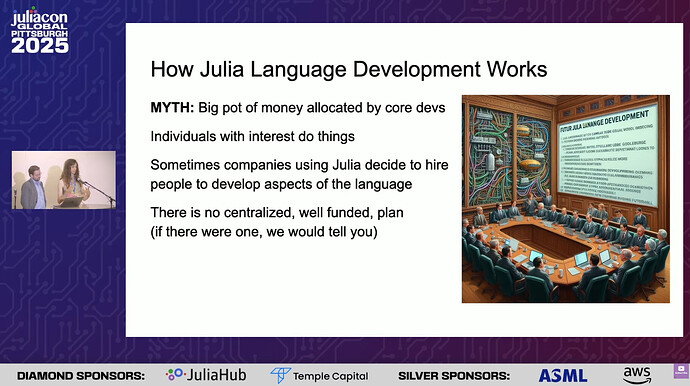I’ve been increasingly wondering: where is Julia actually heading?
As someone trying to evaluate Julia for long-term or industrial projects, it’s quite difficult to understand the language’s broader direction — both technically and strategically. I’m genuinely interested in seeing what areas are being prioritized and what kind of roadmap the community or core team envisions.
Some specific examples of what I’d personally like to understand better but feel free to add something in the comments:
- Is static compilation a current priority? If so, where can I read more about ongoing work or plans?
- Are there efforts to improve startup times or general execution performance ? Maybe only startup times? Maybe only execution performance?
- Is binary size reduction being actively pursued? Or not?
- What’s the status or plan for developer tooling — e.g., the Language Server, debugging tools, IDE support, etc.? I’ve head something about new LS, but what about new debugger?
These are all crucial aspects for many of us trying to decide whether Julia is the right tool for multi-year projects. It’s not just about current capabilities — it’s about knowing what’s likely to improve, what’s on hold, and what’s not on the radar.
Right now, it’s very difficult to find that kind of information. For instance:
- Discussions like this one are dead
- Other threads (like roadmap for small binaries) focus on specific issues, but not the general direction.
- Searching “Julia programming language roadmap” on Google doesn’t show anything useful IMO
- Searching “roadmap” on Discourse yields old scattered topics that are outdated
For industrial or long-term use, the absence of a clear public roadmap (which is up to date) makes planning challenging. If some issues are known and scheduled for attention (say, next year), that’s fine — but without any visibility, it’s impossible to know whether a particular area is a priority or simply not on the radar.
For comparison, other language communities have clear and centralized ways to communicate their development direction. For example, Python has the PEP process, where major changes and long-term visions are publicly discussed and documented. Rust maintains an openly accessible roadmap through RFCs and annual planning discussions. Go has its proposal process and blog posts outlining key upcoming work. Swift publishes detailed evolution proposals and focus areas that let the community understand what’s under consideration. C++ operates through ISO committee papers and regularly publishes C++ standardization roadmaps that outline what features are targeted for upcoming standards (C++23, C++26, etc.). In the JavaScript ecosystem, the TC39 committee maintains TC39 activities where new language features can be tracked from idea to standardization. These models make it easier for developers and companies to align their plans and expectations with the language’s future.
Is there an official or semi-official way to track this? I also tried ChatGPT and Claude with search feature and the response was somewhat like
The Julia community does not appear to provide a consolidated, clearly communicated official roadmap document that states “Next year: X; in 2 years: Y; in 5 years: Z”.
Claude suggested me to learn about it through JuliaCon talks or GitHub discussions. If that is the only way, that’s quite scattered and difficult to follow. JuliaCon talks don’t have a lot of discussions and I doubt the comments on YouTube influence the decisions of the core developers. GitHub discussions are overloaded with technical jargon. E.g. this issue on milestone for Julia 1.13 and I have absolutely no idea what it is about. Does it make language better? Maybe. Does it make more clear where Julia is heading to. Absolutely not.
I also occasionally encounter extremely frustrating discussions on GitHub — for example, one issue reports clear regressions in pre-compilation times yet appears to have been closed (thankfully reopened) without any public rationale as not planned. Beyond the absence of a clear agenda, I’m left asking: who is making the decisions, on what basis, and why are significant (imo) issues closed as “not planned” without explanation? This lack of visible governance undermines my personal trust in the project’s direction.
Would it make sense to have something like a Julia Roadmap dedicated website or even a PEP-style process to document directions, discussions, and rationales for major language or tooling initiatives? That kind of structure would make Julia more predictable and transparent — and much more attractive to organizations planning multi-year adoption.
EDIT: 12 Nov 2025
I appreciate everyones input. For people who joined later, certain actions are being taken here and here



